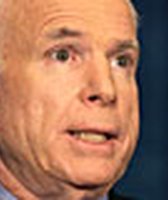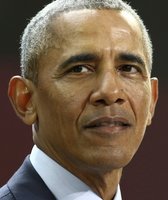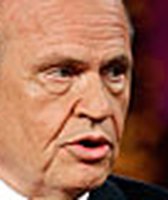Get PolitiFact in your inbox.
SUMMARY: Rudy Giuliani touts his crime-fighting record from his days as mayor of New York, but many experts don't think he deserves all the credit he takes.
The brash-talking former mayor, the candidate vying for the title of real law-and-order star, has made it a centerpiece of his campaign: Under his leadership, New York City ascended from crime capital to America's safest big city.
At campaign stops, in interviews and in speeches, Giuliani, a top Republican contender for president, tells voters that he led the Big Apple's amazing transformation, driving down crime and returning the streets to residents and visitors alike.
And it's true. The violent crime rate dropped by 56 percent during the eight years he served as mayor. Murder, down nearly two-thirds. Robbery, down 67 percent. Aggravated assault, down 28 percent.
A city pegged as ungovernable was suddenly born again.
But Giuliani's big claims come with big caveats. While the statistics he cites are accurate, independent experts and studies of the phenomenon suggest Giuliani exaggerates his role. Consider:
• Violent crime in New York began falling three years before Giuliani took office in 1994, U.S. Justice Department records show. Property crime began falling four years before. The decline accelerated during his administration, but the "turnaround" he claims credit for started before him.
• New York was no anomaly, but was part of a trend that saw crime fall sharply nationwide in the 1990s, particularly in big cities. The city with the best record for reducing violent crime during this period? San Francisco.
• Independent studies generally have failed to link the tactics of the Giuliani administration with the large decrease in crime rates.
Rather, many criminologists believe the decline in New York, as in Chicago, San Diego, Miami and elsewhere, was the result of a complex mix of social and demographic changes, including a break in the crack cocaine epidemic, an improving economy, and increased prison terms for proven lawbreakers.
Better policing tactics and policies were likely part of it, experts say, but not to the extent Giuliani claims.
"Demographics have an awful lot to do with this, and these are very, very large social forces," said Jeffrey Fagan, co-director of the Center for Crime, Community and Law at the Columbia Law School in New York. "It's hard to imagine policing, no matter how smart and effective it is, giving the kind of leverage ... to move a macro force like crime."
To be sure, even Giuliani's critics, including Fagan, praise him for reorganizing the New York Police Department and providing the resources it needed. He gave precinct captains decision-making authority and backed CompStat, an innovative program that tracked crime and held commanders responsible for their sectors.
He also brought confidence to a police force that felt besieged and demoralized under the previous Democratic administration. Howard Safir, the city's police commissioner from 1996 to 2000, said Giuliani deserves the credit because he provided leadership and badly needed support.
More pointedly, Giuliani instituted a zero-tolerance approach to crime-fighting, which allowed police to stop and frisk suspicious people and make arrests for minor infractions that once had been ignored. This approach was based on a theory called "Broken Windows," by criminologists George Kelling and James Q. Wilson, which contends that low-level disorder leads to increased blight and crime. Cracking down on minor offenses such as loitering, prostitution and aggressive panhandling is the way to prevent more serious ones.
"I was criticized for being too aggressive about the enforcement of the laws ... but the reality is, I began with the city that was the crime capital of America," Giuliani told Fox News Sunday in May. "When I left it was the safest large city in America. You don't do that by not aggressively enforcing the laws."
A 2001 study by Kelling and William Sousa, published by the conservative Manhattan Institute, supported Giuliani's application of the Broken Windows theory, and it noted the increase in misdemeanor arrests in the 1990s correlated with New York's decrease in homicides.
But whether the two are related remains a matter of debate. As one team of skeptical researchers noted, the decrease in murders also corresponded with the rise in New York Yankees baseball championships.
Violent crime in New York began to turn in 1990, but polls found most New Yorkers didn't feel it. They were receptive in 1993 to Giuliani's campaign promises to hire more cops and target not just the murder but the mayhem.
When he took office in 1994, Giuliani kept his word. Over the next eight years, the NYPD grew from 28,000 officers to 40,000. He hired William Bratton, a Broken Windows disciple who cracked down on graffiti, fare-jumping and other minor offenses in the city's transit system. Crime in the subways dropped about 27 percent.
Bratton and a deputy commissioner, the late Jack Maple, also developed what Giuliani later called the crown jewel of his administration: CompStat.
Before Bratton, crime statistics were compiled downtown, and then largely shelved. Bratton invested in new computers that allowed the department to track crimes weekly. Precinct commanders, on the hook for crime rates in their sectors, had the latitude to try new tactics.
"The precinct commander would have known his stats for the week, and the people downtown would know the stats. So when they had these weekly meetings, they were more or less discussing crime in real time," said Dennis C. Smith, a professor at New York University's Wagner School of Public Service who has studied CompStat since its inception. "That was transformative."
Dozens of cities have implemented similar programs based on New York's apparent success. Giuliani has promised that if elected president, he will use CompStat-style programs to improve the federal government.
But Andrew Karmen, a sociologist and criminologist at the John Jay College of Criminal Justice in New York, notes that crime is now rising in several CompStat copycats, including Boston and Baltimore. "CompStat is not some sort of sure-fire, miracle way of organizing an agency and getting maximum output from it," said Karmen, author of New York Murder Mystery: The True Story of the Crime Crash of the 1990s.
Safir, who replaced Bratton, says the proof that CompStat works is the continuing decline in crime in New York, where Mayor Michael Bloomberg has improved the system.
"CompStat is not brain science, CompStat is holding people accountable for performance," said Safir, chairman of First Responders for Rudy. "I've watched lots of police departments that implemented CompStat fail because they were unwilling to make the hard choices."
From a political standpoint, Giuliani's crime-fighting policies are tough to assail: Intuitively, they just make sense.
But from the standpoint of the social scientist, public policies have costs and consequences — some unintended.
Part of Giuliani's effort was a program called "Stop and Frisk," which encouraged police to stop suspicious people on the street to look for guns, outstanding warrants or drugs.
Aside from questions it raised about constitutionality, a 1999 study by the New York Attorney General's Office found that "Stop and Frisk" was unevenly applied — minorities were stopped disproportionately — and led to relatively few arrests. Often, people were detained but never charged. Although Giuliani's policies appear to have passed the ultimate test — crime did go down — researchers seeking empirical evidence have come up short.
In a 2003 review, the National Research Council found little data to support the claim that the Broken Windows theory of policing works.
"There is a widespread perception among police policymakers and the public that enforcement strategies (primarily arrest) applied broadly against offenders committing minor offenses lead to reductions in serious crime," the report said. "Research does not provide strong support for this proposition."
One researcher who examined New York's use of Broken Windows concluded that it wasn't much of a factor.
"I am pretty confident even without Broken Windows policing in New York City, crime would have come down to the extent that it did," said Bernard Harcourt, a professor of law and criminology at the University of Chicago. "New York was a leader, but not in every category, and on every comparison." Kelling, the father of Broken Windows, says critics raise "a valid point that science has not proven that it was Broken Windows or it was the police department in New York City. But one has to ignore a hell of a lot of coincidences to deny that it's not."
Giuliani has promised to take the strategies he used in New York to the nation. The idea is that if he could shine the Big Apple, he can restore order to Washington, and keep America safe. There would just be a whole lot more at stake.
Our Sources
Do Police Matter? An Analysis of the Impact of New York City's Police Reforms, by George L. Kelling and William Sousa.
Shattering 'Broken Windows': An Analysis of San Francisco's Alternative Crime Policies, Center on Juvenile and Criminal Justice, San Francisco, CA
Performance Management in New York City: Compstat and the Revolution in Police Management, by Dennis C. Smith and William J. Bratton, as published by the Rockerfeller Institute of Government at the State University of New York.
The Remarkable Drop in Crime in New York City, by Patrick A. Langan and Matthew R. Durose, Bureau of Justice Statistics, U. S. Department of Justice, October 21, 2004
Department of Justice,Bureau of Justice Statistics





































